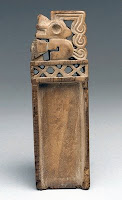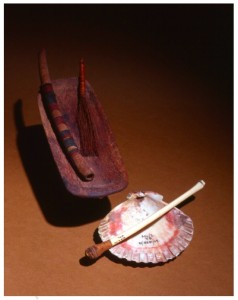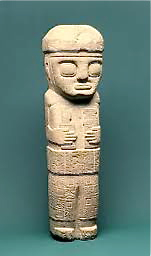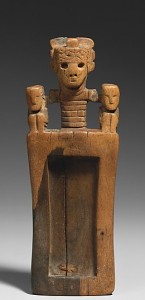Tiwanaku is an important Pre-Columbian archaeological site in western Bolivia. Tiwanaku is recognized by Andean scholars as one of the most important precursors to the Inca Empire, flourishing as the ritual and administrative capital of a major state power for approximately four hundred years between 700 and 1100 A.D.
 |
| Wooden snuff tablet |
There has been good reason to believe that the inhabitants of Tiwanaku utilized an insufflated hallucinogen. They produced a variety of small carved objects that included puma and jaguar effigies, incense burners, and decorated wooden snuff tablets. Many mummies and skeletons from this culture were buried with such tablets and snuffing kits. One archaeologist reported recovering 614 snuffing kits from a single excavation.
Chemical analysis of samples of archeological snuff powders from such kits has indicated the presence of bufotenine, dimethyltryptamine, and 5-MeO-DMT. The presence of bufotenine suggests that the source of the powder was any of several DMT-rich plants in the genus Anadenanthera; small pouches containing Anadenanthera seeds have also been found in several burials. CAT scans of Tiwanakuan skulls have shown signs of chronic perinasal damage in some cases, likely caused by frequent sniffing of Anadenanthera.
 |
| Snuffing kits |
Anadenanthera species are used as hallucinogens today by the peoples along the Orinoco river, in the form of a snuff called yopo, cohoba, vilca, or huilca. Among the Guahibo, the snuff is widely and frequently used as a stimulant; among the Tunebo, it is used only by shamans. We can only guess the circumstances under which the Tiwanakuans used it.
Psychoactive alkaloids accumulate in hair and other body tissues; so a test of hair samples would provide direct evidence for hallucinogen use among the Tiwanakuans. A recent paper in the Journal of Archaeological Science, entitled “Identification of psychoactive alkaloids in ancient Andean human hair by Gas Chromatography/Mass Spectrometry,” reports an analysis of the chemical composition of hairs from 32 mummies from northern Chile, dating to the Tiwanakuan expansion, looking specifically for harmine and 5-MeO-DMT.
 |
| Stone figure holding two snuff tablets |
The results were surprising. None of the 32 mummy hair samples tested positive for 5-MeO-DMT, and two tested positive for harmine. This certainly appears to be inconsistent with the results of the testing of snuff powders from archeological snuff kits. Moreover, one sample testing positive for harmine came from an adult male, who had a snuffing tablet in his grave, and a sclerotic process in the perinasal area; but the other was from a one-year-old infant, also buried with a snuffing tablet. There is only one likely source for the harmine in these two samples — Banisteriopsis caapi, the ayahuasca vine, which must have been imported, over some distance and rough terrain, from the Upper Amazon.
 |
| Wooden snuff tablet |
What can we make of this? Both the absence of 5-MeO-DMT and the presence of harmine are puzzling. The results appear to indicate that the ayahuasca vine was consumed without the addition of a DMT-containing companion plant such as chacruna, although clearly, given the apparently extensive trading network that allowed the importation of the ayahuasca vine, such plants would have been available. The snuffing tablets appear not to be associated with ingestion of Baniseriopsis. And how in the world did harmine get deposited in the hair of a one-year-old? Was the ayahuasca vine administered as a medicine independent of any potential psychoactive effect? Did the Tiwanakuans — like the Guahibo or Piaroa today — combine sniffing Anadenanthera with chewing the ayahuasca vine?
“We think that Banisteriopsis was not necessarily used as a hallucinogenic mixture, and perhaps was used in therapeutic practices. It is also possible that its consumption with snuffing kits was used as element of social differentiation,” one of the authors said in an interview.
The investigation of hallucinogen use in antiquity has certainly taken a methodological step forward with this study. It is just not clear where that step has taken us.

- Previous Post: The Amazon River
- Next Post: The Single Active Molecule
- More Articles Related to: Indigenous Culture, Research Studies, Sacred Plants



This discussion sprang on the enteógenos group some time ago and someone pointed that (from wikipedia) “The harmine-containing plants listed include tobacco, two species of passion flower/passion fruit, and numerous others.”
I have no idea what the harmine content in tobacco is, but it does seem more likely that the harmine in the hair could come from tobacco?
“Tobacco contains the harmala alkaloids harman and norharman, and the closely related harmine and harmaline are known hallucinogens. The levels of harman and horharman in cigarette smoke are between forty and 100 times greater than in tobacco leaf, showing that the burning of the plant generates this dramatic increase.”
http://www.biopsychiatry.com/tobacco/
or
http://www.jstor.org/pss/648207
definitely an interesting thread to investigate…
That is a very interesting idea. GC/MS is usually pretty accurate, and I would guess that it would not misidentify harman or norharman as harmine. At the same time, I do not know what metabolic processes might be involved. Also, although there is no question that tobacco can be hallucinogenic in sufficient doses, as I discuss here, I do not know what evidence there is that the Tiwanakuans used tobacco, or used it for that purpose. I would be grateful for any further information on this point.
And thank you, as always, for your wonderful blog Legitimos Guerreritos.
Not specifically related to this post, Steve, but I am heartened to see regular posts again on Singing to the Plants.
Your blog is a mature and scholarly discussion of the subject of curanderismo, and I much appreciate it.
Thank you for your very kind words. You have just warmed my heart on a bitterly cold day. :-) I am really happy that you are getting something useful out of the blog.
Pleasure’s mine. I have just returned from a year in Peru to discover that knee jerk responses in relation to plant spirit based curanderismo are seemingly stronger than ever in Australia…and this in a time where common sense seems to dictate that we do everything we can to forge harmonious relationships with the worlds around us.
Balanced and informed discussions such as yours hearten me..
Heat wave here!
I have heard that in native communities, for instance the shipibo conibos of Pucallpa, gave traditionally a very small amount of ayahuasca to very small children, in order that they get costumed to the ayahuasca flavor. We could also infer that shipibos want that the spirit of the plant protect or be part of their children